Sharing how I got paid to live in Antarctica, how to get a job on the ice, and everything you need to know about life at McMurdo Station. With a lot of Bourdain quotes.
After six years of finding jobs that would pay me to travel the world, I was determined to somehow get paid to live in Antarctica, too– the final frontier and the last continent in my quest to visit all seven continents and sail through the Seven Seas.

It was only after seeing Anthony Bourdain’s trip down to “the ice” (Antarctica) on Parts Unknown (go ahead, roll your eyes; I have no shame) that I realized it was possible to see the white continent the same way I’d seen the rest of this planet: with a paycheck.
Related: 7 Continents & 7 Seas: How I Got Paid to Travel the World
Tony inspired a lot of people with that Antarctica episode– not just me– to see and experience life on the ice.
Now nearly four years into my ice career, I hope this guide serves to inspire and encourage the next; to spark an interest in the mesmerizing, unique, and last untouchable place on this planet that is Antarctica.
Can you live in Antarctica?
While there are a select handful of tourist expeditions that offer overnight experiences in Antarctica, the only people who actually live on the ice are those working at research facilities.
If you work at one of the research stations in Antarctica, you can live on the ice for approximately up to a year and a half at a time before you need to go off continent for a few weeks.

How many research stations are there in Antarctica?
Internationally, there are currently 43 active permanent research stations operating year-round in Antarctica with an additional 50 facilities with seasonal operations in the summer (as of 2020).
The United States has three permanent research stations in Antarctica:
- McMurdo Station: the largest station on the continent and located on Ross Island
- Amundsen-Scott South Pole Station: located at the geographic South Pole
- Palmer Station: located in the Antarctic Peninsula

How do you get paid to live in Antarctica?
There are two general categories of people who get hired to live and work on Antarctic research stations: scientists and support staff.

Why are scientists needed in Antarctica?
The White Continent is central to understanding a lot about our world: the environment, the climate, the oceans, the atmosphere, space, and so much more.
This is due to Antarctica being largely untouched and uninhabited unlike other continents, as well as its unique location and environment.
At a time when science is held in open contempt…when painfully acquired data is actually being deleted from computers if it conflicts with preconceived policies, these guys are looking at some deep stuff.
Anthony Bourdain, Parts Unknown: Antarctica
The scientific findings from Antarctica provide us with rich information about the world that extends through numerous areas of studies.
From biologists studying the Dry Valleys to NASA utilizing the ice’s rare conditions to test equipment for future space missions, there is an abundance of research activity happening in the harshest continent on Earth.
- Antarctica is home to 4/5 of all known meteorites
- One of the eight ground-based radio telescopes used to capture the first image of the black hole was located at the South Pole
- Antarctica is the largest desert in the world
Fun Facts
What support staff jobs are in Antarctica?
As the saying goes, it takes a village.
On the ice, science cannot move forward without a team of people to support them with all the necessary provisions: operating facilities, mechanics, machine operators, cooks, plumbers, electricians, carpenters, medical staff, firefighters, airfield operators– the list goes on.
Any job you could think of that is needed to run a small and isolated town, there’s probably a position for that.
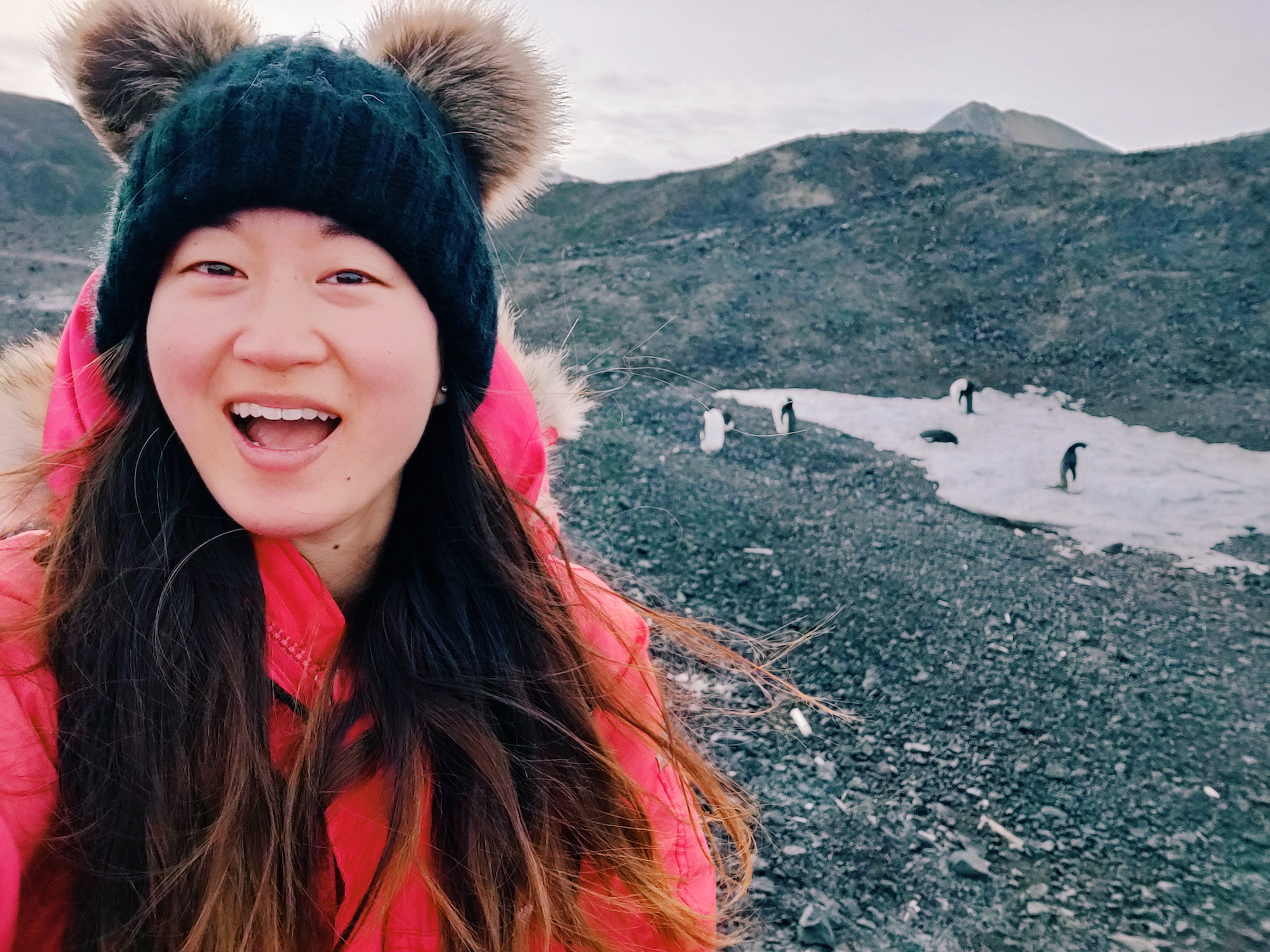
How do I get a job in Antarctica?
Lucky for you, I wrote an entire guide about jobs in Antarctica!
I’ve included info on the three main types of employment opportunities/ programs/ companies that will pay you to get to the Ice (besides research stations).
Get your FREE copy here, or read on for the highlights about how to get a job at Antarctic research stations.
Americans
The United States Antarctic Program has a jobs and opportunity page where you can find a full list of agencies to apply with.
There are five primary contractors that the program works with and these are usually where most participants are able to find opportunities that eventually bring them to the ice:
- GANA-A’YOO Services Corporation (GSC): Food, housing, janitorial, waste, retail, and postal services
- GHG Corporation: Engineering and IT
- Leidos: Operations and logistics
- Amentum: Infrastructure, operations, transportation, and logistics
- University of Texas Medical Branch (UTMB): Medical

Additional contractors include:
- Air Center Helicopters, Inc.: Helicopter support
- Kenn Borek Air Ltd: On continent twin Otter aircraft support
Several branches and task-forces of the U.S. military also provide support to the continent and American stations:
| Branch/ Task-Force | Operation/ Wing | Support |
|---|---|---|
| Join Task Forces Support Forces Antarctica | Operation Deep Freeze | Logistics |
| The U.S. Air Force | USAF 62nd Airlift Wing, McChord AFB, Washington | Airlift support |
| The Air National Guard | New York Air National Guard 109th Airlift Wing | LC-130 air support |
| The U.S. Coast Guard | –PACAREA Icebreaker Operations –Cutter Polar Sea –Cutter Polar Star | -Icebreaker and vessel support -Fuel delivery |
| The U.S. Navy | -NIWC -Polar Programs IPT | -Weather forecasting -Air traffic control -Systems maintenance -Information security |

Non-Americans
There are 31 countries besides the United States with active permanent or seasonal research operations in Antarctica.
You can find the various Antarctic programs here with links to their employment pages (if available).
[mks_accordion][mks_accordion_item title=”Argentina”]Argentine Antarctic Institute[/mks_accordion_item][mks_accordion_item title=”Australia”]Australian Antarctic Division[/mks_accordion_item][mks_accordion_item title=”Belgium”]International Polar FoundationBelgian Federal Science Policy Office[/mks_accordion_item][mks_accordion_item title=”Belarus”]National Academy of Sciences of Belarus[/mks_accordion_item][mks_accordion_item title=”Brazil”]Brazilian Antarctic Program[/mks_accordion_item][mks_accordion_item title=”Bulgaria”]Bulgarian Antarctic Institute[/mks_accordion_item][mks_accordion_item title=”Chile”]Chilean Antarctic Institute[/mks_accordion_item][mks_accordion_item title=”China”]Polar Research Institute of China[/mks_accordion_item][mks_accordion_item title=”Czech Republic”]Czech Antarctic Research Program at Masaryk University[/mks_accordion_item][mks_accordion_item title=”Ecuador”]Ecuadorian Antarctic Institute[/mks_accordion_item][mks_accordion_item title=”Finland”]Finnish Antarctic Research Program[/mks_accordion_item][mks_accordion_item title=”France”]French Polar Institute Paul-Émile Victor[/mks_accordion_item][mks_accordion_item title=”Germany”]Alfred Wegener Institute
German Aerospace Center[/mks_accordion_item][mks_accordion_item title=”India”]National Centre for Polar and Ocean Research[/mks_accordion_item][mks_accordion_item title=”Italy”]National Antarctic Research Program[/mks_accordion_item][mks_accordion_item title=”Japan”]National Institute of Polar Research[/mks_accordion_item][mks_accordion_item title=”Netherlands”]Netherlands Organization for Scientific Research[/mks_accordion_item][mks_accordion_item title=”New Zealand”]Antarctica New Zealand[/mks_accordion_item][mks_accordion_item title=”Norway”]Norwegian Polar Institute
[/mks_accordion_item][mks_accordion_item title=”Pakistan”]Pakistan Antarctic Programme[/mks_accordion_item][mks_accordion_item title=”Peru”]Peruvian Antarctic Institute[/mks_accordion_item][mks_accordion_item title=”Poland”]Poland Institute of Biochemistry and Biophysics: Arctowski Polish Antarctic Station[/mks_accordion_item][mks_accordion_item title=”Romania”]Romanian Polar Research Institute[/mks_accordion_item][mks_accordion_item title=”Russia”]The Arctic and Antarctic Research Institute[/mks_accordion_item][mks_accordion_item title=”South Africa”]South African National Antarctic Programme[/mks_accordion_item][mks_accordion_item title=”South Korea”]Korea Polar Research Institute[/mks_accordion_item][mks_accordion_item title=”Spain”]Spanish National Research Council[/mks_accordion_item][mks_accordion_item title=”Sweden”]Swedish Polar Research Secretariat[/mks_accordion_item][mks_accordion_item title=”Ukraine”]National Antarctic Scientific Center of Ukraine[/mks_accordion_item][mks_accordion_item title=”United Kingdom”]British Antarctic Survey[/mks_accordion_item][mks_accordion_item title=”Uruguay”]Uruguayan Antarctic Institute
[/mks_accordion_item][/mks_accordion]
Is it hard to get a job in Antarctica?
In general, jobs in Antarctica tend to be pretty competitive for an obvious reason: there are a lot of people who want the unique opportunity to work and live on the ice, but there is a limited number of positions available.
It’s not uncommon for people to apply for a few years before they ever hear back or make it through the initial application filtering process.
Bottom line: it’s not impossible to get a job in Antarctica, but it may require some patience.

What is life like in McMurdo?
McMurdo is a small town of hard workers with a passion for adventure and a thirst for knowledge.
It ain’t pretty. It looks like a mining camp… [It’s] a community– a tightly knit, highly organized, very odd subculture of just under a thousand people in summer, and 150 in winter, all working toward the same thing in this most remote, barren, yet stunningly beautiful continent.
Anthony Bourdain, Parts Unknown: Antarctica

This section covers all the ins and outs of life in MacTown: work, recreation, demographics, culture, weather, food, and wildlife.
Related: 20 Things You Didn’t Know About Life at McMurdo Station, Antarctica
Work
Everyone works roughly 54 hours over six days a week.
While the main operating hours in McMurdo (“town hours”) are typical business hours Monday through Saturday, the station runs 24/7 in the summer so there are always people needed around the clock.
Usually, departments will rotate everyone’s schedule every few weeks so that you don’t get stuck with one shift.
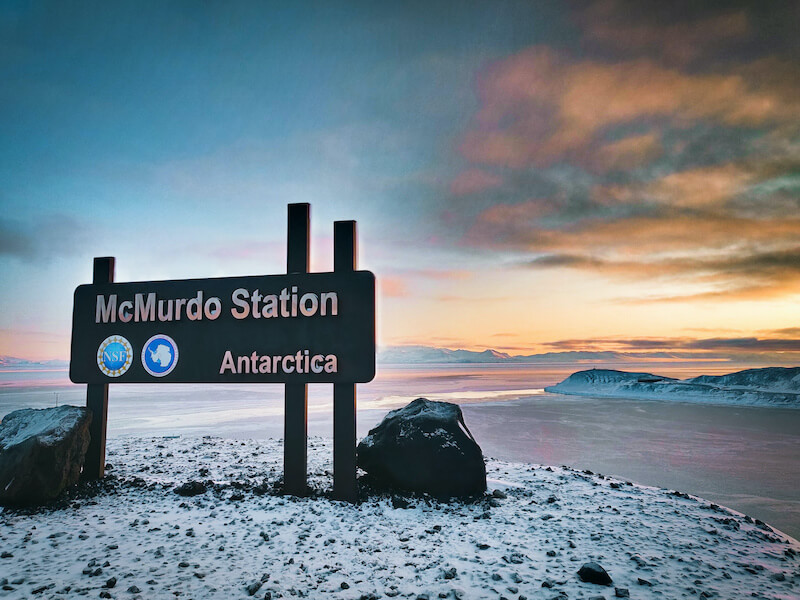
Living Accommodations
There are a number of dorm buildings on station and most people will have at least one roommate, although in the height of the summer season it’s not uncommon to have up to four people to a room in the largest dorm (Building 155).
Some dorms have communal bathrooms and others share a bathroom between two rooms.

Lifestyle and Recreation
Because McMurdo is the largest station in Antarctica, there are so many things to do.
Here are some of the recreational activities and facilities available in town:
- Fitness: Exercise classes, cardio gym (“gerbil gym”), weight room, fun runs/ races
- Sports: Volleyball, soccer, basketball, climbing wall, indoor hockey, hiking, skiing, softball
- Leisure: Crafts room, band room, sauna
- Educational: Library, historic tours, science lectures, travel presentations
- Bars/Cafes: Southern Exposure, Gallagher’s, Coffee House, The Tatty Flag (this is the bar at Scott Base, the nearby Kiwi Base where McMurdans can visit on select dates, aka “American Night”)
- Social: Themed/holiday parties hosted by various departments, Ice Stock (the annual outdoor New Year’s music festival), karaoke, live music, trivia, open mic, film showings, board games
- Clubs: Photography, chess, language exchange
- Religious services at the Chapel of the Snows: Nondenominational services, Protestant worship services, Bible studies
- Wellness: 12-step programs, meditation, yoga
Demographics
Gender
Although every season will vary, the typical demographics of McMurdo is approximately 70% male and 30% female.
I’ll be completely honest, the significant gender difference made for some interesting times which were not always pleasant.
Don’t get me wrong, there are some amazing guys down there; but due to my position working in the galley (cafeteria), dealing with misogynistic comments and just overall disappointing behavior from quite a few less than stellar men was a regular occurrence at work for me and my female coworkers.
That being said, I think the women that are on the ice are some of the toughest you’ll ever meet.
There’s a phrase I heard tossed around that I think is pretty accurate:
Antarctica: Full of badass women and mediocre men.
Racial Diversity
The population is as white as the continent.
Although, there was a sizable group of us minorities, especially in the height of summer during vessel season (when American and Kiwi military come to aid in providing the town with the necessary supplies and fuel for the year).
Keep in mind, when I say “sizable,” I mean there were enough of us minorities that I didn’t know all of us by name, but we definitely were all aware of each other.
And if someone was trying to describe one of us, it wouldn’t take long to figure out who you were talking about.
For example, all you needed to identify me was with, “The Asian girl in the galley.”
Because I was the only one.
But if you were trying to describe most guys on station, it pretty much went like, “White guy, dark hair, beard, about six foot…” ¯\_(ツ)_/¯
And they were probably named some variant of Jon/John or Brian/Bryan.

Age
While I expected the majority of people on station to be in their 20s or early 30s like myself, I think the average age during my first season in 2019-2020 must have been closer to late 30s to mid 40s.
But overall, there are people of all ages down on the ice.
One of my roommates was even a retired, world-traveling grandma with quite a remarkable life story.
Occupation
Most of town are working blue collar, hands on jobs; and a lot are working outdoors all day.
Those indoors are typically either scientists, service and facilities workers, or administrative staff.

Culture
McMurdo is a unique place where science meets adventure; where researchers are at the top of their field and where food service and janitorial workers have some of the craziest backgrounds you’ll ever hear of; where academics and military party together, where misfits and outliers belong.
There is a curiosity in everyone who comes here. It’s a continent of travels, of seekers, united in the continuation of exploration, learning, the search for greater understanding, the pursuit of pure knowledge.
Anthony Bourdain, Parts Unknown: Antarctica
One of my favorite aspects of life in McMurdo that I think many former McMurdans might agree with is that there is a huge culture of respect across occupations and mutual understanding that everyone has something to bring to the table.
Regardless of what you’re on the continent to do, once you’ve made it, you’re part of the exclusive albeit sometimes weird community of misfits.
Everyone has accomplished so much in their own lives away from the ice.
Near death experiences and stories of adventurous peril are just a dime a dozen.
I’d even venture a guess that it’s probably the only place on this planet where you’ll find a considerable amount of people in a single city who’ve been to all seven continents.
And as such, everyone is eager to hear about each others’ stories and life outside of the ice, no matter what your job on station is.
It’s the perfect environment to meet people you’d never come across in your normal life off continent.
In fact, a few of the closest friends I made on the ice could not have been more different than me: two middle-aged white guys from the other side of the country.
And because there’s limited WiFi (more on that later), you actually talk to other people while eating instead of staring at your phone.
Meals can quickly turn into an hours-long event having discussions with people who sound like fictitious superhero movie characters because you think there’s no way that an actual human with such a remarkable and seemingly impossible life could exist. And yet, in McMurdo— they do.
Related: Life at the South Pole Station: Everything You Want to Know
Seasons
Antarctica officially has two seasons: summer and winter, although there is some semblance of a spring and autumn as well.
Summer is marked by 24 hours of daylight, and in the winter 24 hours of darkness.
Life in McMurdo follows these seasons with its own yearly timeline that looks a little like the following:
August- September: WinFly
Short for “Winter Fly-In,” this is the period where early-season personnel are flown in to begin operations for the main summer season.
This is the continent’s spring, with the sun starting to come back and temperatures slightly warming up.
October- February: Mainbody
This is the main summer season where most of the year’s activities take place.
Temperatures are warmest in January.
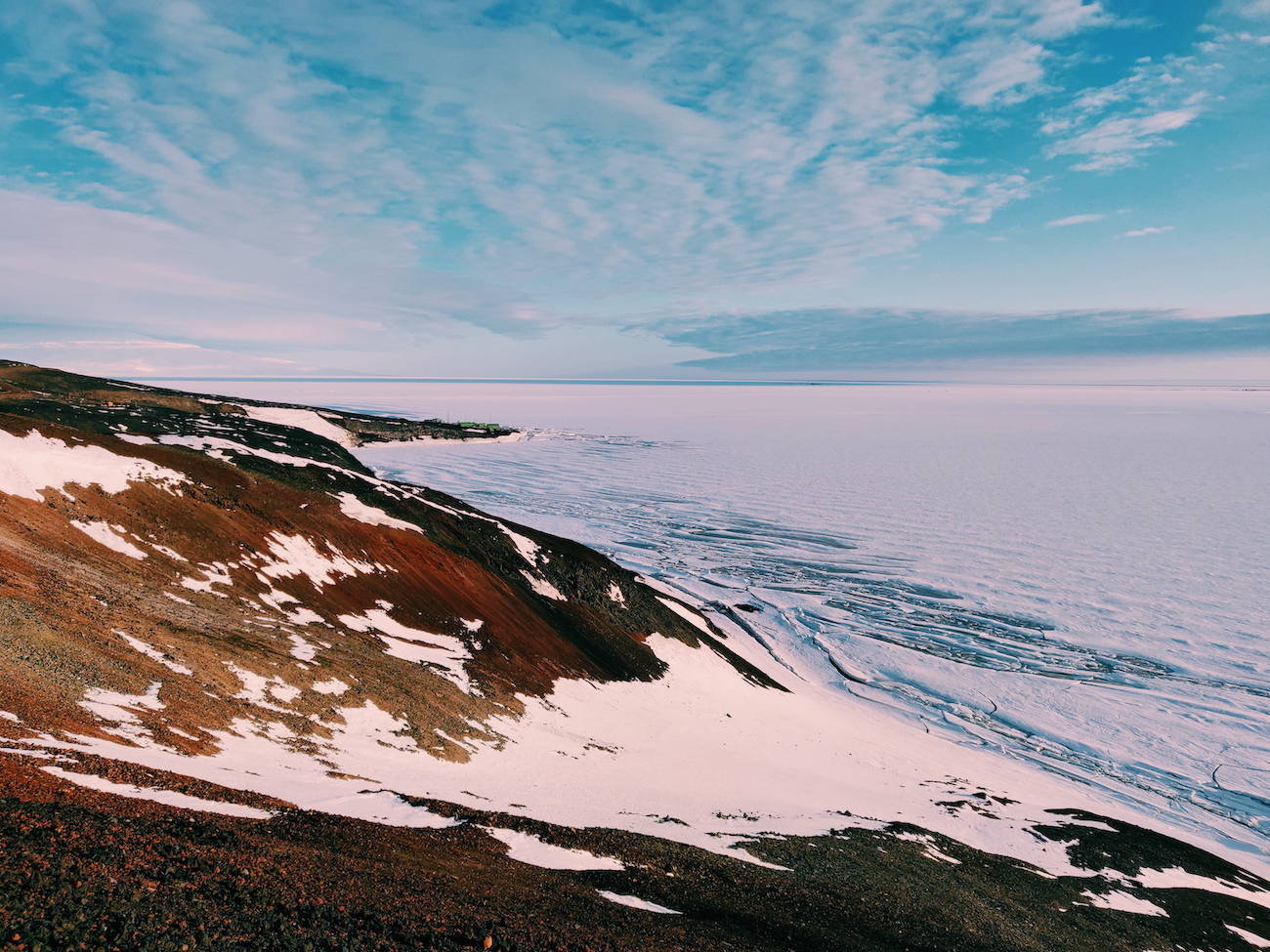
January- February: Vessel
This is the busiest period as a few large vessels arrive with a year’s worth of supplies and fuel.
Both American and Kiwi military are brought in to help unload everything.
It’s a massive operation that usually bumps up the town’s population by a few hundred people.

February- April: WinFall
February marks the end of mainbody and when the majority of personnel leave the ice.
Flights in and out of the continent reduce to roughly one or two a month during this autumn season with some support staff lingering on station until the last flight before winter.
Winter-Overs (people staying to keep the station operating through the winter) typically arrive during this time as well.
Around March, the sun will set for the first time and the days will gradually become more dim.

April- August: Winter
The sun sets for the last time late April and rises once again in late August.
This is also when the auroras in Antarctica are visible.
Related: Antarctica Southern Lights Guide
Temperatures
In the austral summer, temperatures typically range from 10°F (-12°C) to 33°F (1°C), with an average temperature of 28°F (-2°C) in January (the hottest month).
In the winter, temperatures stretch between -23°F (-31°C) to 0°F (-18°C), with July (the coldest month) averaging at -15°F (-26°C).
Historically, temperatures on station have dropped as low as -58°F (-50°C) and risen as high as 45°F (8°C).

Weather
The weather in Antarctica can be unpredictable, harsh, and unforgiving.
It controls most of life on the ice and decides whether or not operations can take place as personnel safety is of the utmost importance.
Planes can make it within minutes of landing on the ice and get turned back the 5-7 hours to Christchurch if the visibility isn’t right.

McMurdo has a three-class weather system in place that dictates what activities and movements can or cannot take place depending on visibility, wind speed, and temperature.
- Condition 3: This is the normal weather condition where everything is operational and there are no travel restrictions in place. Con 3 is also the only time recreational travel is permitted.
- Condition 2: Reduced visibility and moderate wind speed. Those authorized to leave town need to check out a radio with the Firehouse and check back in upon returning.
- Condition 1: This is the most severe weather condition. Besides mission-critical travel, all movement is restricted, included walking between buildings as the lack of visibility could cause you to easily get lost just walking across the road.
Internet and WiFi
Internet in Antarctica is slow.
Even though there is access, if too many people are online at the same time, a simple webpage will be impossible to load.
This is especially the case in summer where the population can increase to over 1000 people (1300 was where we maxed out in 2020. Gross.)
Sites used regularly such as email or social media may have to be used through a “basic” setting instead of the typical interface if you want any chance of having access to it.
And even then, there’s no guarantee that it will load in a reasonable amount of time.
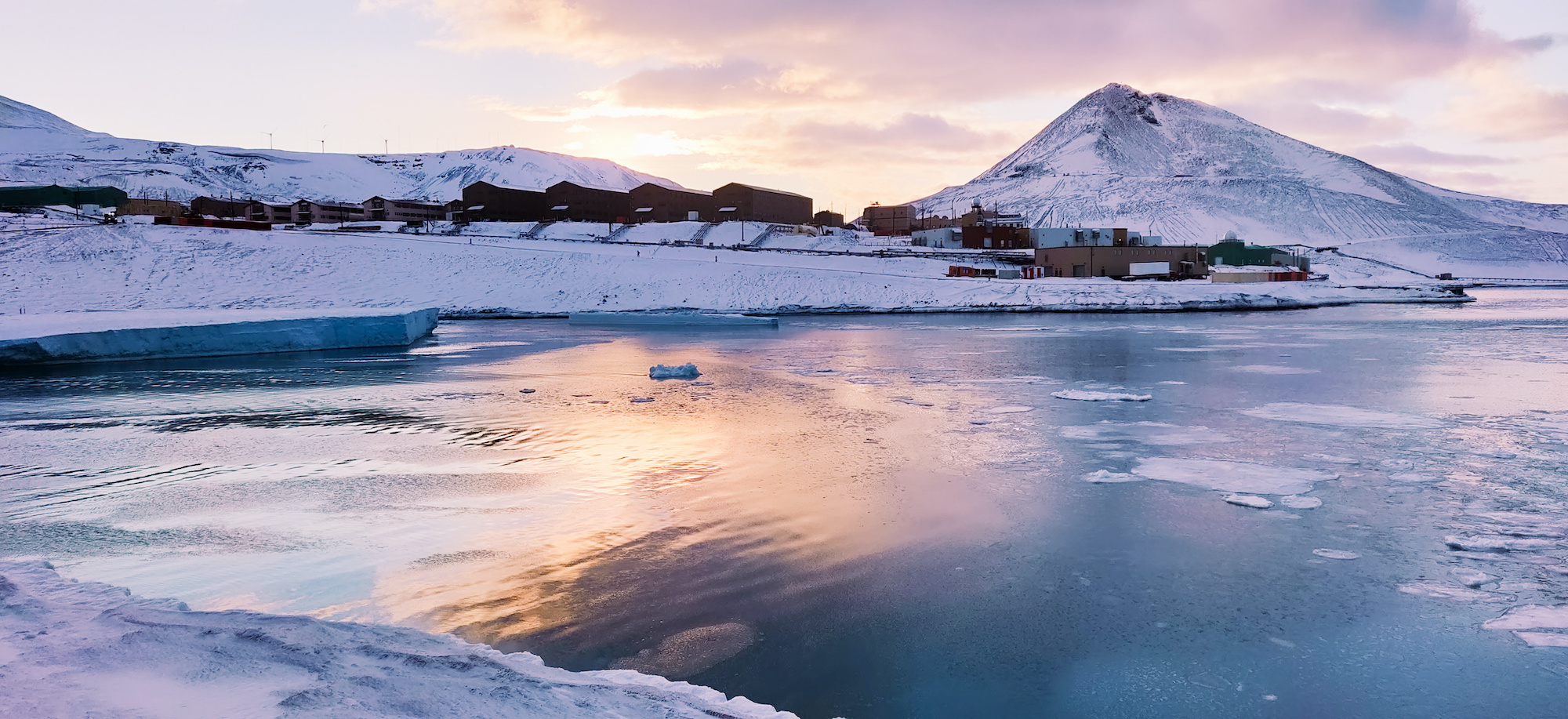
While there is broader and more updated Wi-Fi access than pre-COVID due to Starlink, it’s still limited and speed varies– so be prepared to disconnect, live in the once-in-a-lifetime bubble that is Antarctica, and make new friends with the people around you.
Food
While there are no restaurants, there is one cafeteria on station that feeds everyone in town.
Fortunately, you won’t be eating penguins and seal blubber like the early explorers.
Vessels and flights in the summer bring in fresh fruits and vegetables, known as freshies— the most coveted items on station and only spoken of while salivating and dreaming of life on a less desolate continent.

Typical Meals in McMurdo
There are three meal times a day with an additional midnight meal “rationed”/ designated for MidRats, aka night shift workers (MidRats is short for “midnight rations”).
Each meal has a selection of soups, hot foods, salads, fruits, and freshly baked bread and desserts.
During breakfast, there’s an egg station where you can order eggs as you would at a restaurant: scrambled, over easy, or an omelette with an assortment of toppings.
Dinner includes a live-action station where you can customize whatever the special of the day is: burger, sandwich, burrito, stir fry, etc.
Although limited, there are always vegetarian, vegan, and gluten-free options available for every meal.
All day, there is fresh pizza available (some of the best I’ve had in my life, by the way) as well as a deli section where you can make your own sandwich.
The galley also has a “grab and go” refrigerator where you can take packaged leftovers and snacks at any time.
During the holidays, the kitchen staff pulls out all the stops and prepares elaborate meals and spreads that are as good as holiday meals get, in my opinion.

Themed Meals
If there’s one thing you should know before you come, it’s that McMurdo loves its themed meals and there’s no escaping it.
Every Sunday is brunch day, where all the typical brunch-y foods can be found, including a smorgasbord of crackers, dips, cheeses, shrimp, smoked salmon, and seared tuna.
Every Tuesday lunch is Taco Tuesday, which consists of all the standard taco fixings as well as tortilla chips and melted nacho cheese.
Other themed meals include Greek night (gyros) and the bane of my existence: Asian night, aka Panda Express: Ice Edition.
So, really— how’s the food in McMurdo?
All in all though, regardless of themed meal or not, the food on station was miles better than what I had expected.
The kitchen staff is amazing all in their own right, but in Antarctica, they have to make do with what they’re given.
They do the best they can, and it’s pretty impressive what they’re able to put together despite the limitations.
And honestly, coming from someone who’s worked on cruise ships, the food in McMurdo is better than what I ever ate onboard as a crew member.

Wildlife
There are a limited number of animals you’ll come across in McMurdo:
- Skua: scavenger birds that are basically savage, ‘roided turkeys in the sky
- Whales
- Seals
- Penguins: Adelie and Emperor
The sight of penguins is always an event in town, but it’s not always guaranteed.
While they typically make an appearance in the summer, some seasons there are only sparse sightings, and others— like my season— they can be seen nearly everyday.
If you are lucky enough to make it down to the ice, be sure to check out some Antarctica photography tips and bring a great camera to capture some of the most unique wildlife sightings you’ll ever encounter in your life!
Final Thoughts: Working at McMurdo Station
Antarctica is the last un-fucked-up place on Earth. Chances are you can’t go there.
Anthony Bourdain, Parts Unknown: Antarctica
It’s not easy to see Antarctica, let alone getting paid to go down there.
But if you’re patient and lucky enough to find yourself at the end of the world, you likely won’t be disappointed.
Additional Antarctica Posts:
- How to Get a Job in Antarctica
- 20 Things You Didn’t Know About Life at McMurdo Station, Antarctica
- McMurdo Station Packing List for Working in Antarctica
- How to Get Paid to Travel to Every Continent (Yes, Even Antarctica)
- Life at the South Pole Station: Everything You Want to Know
- Antarctica Northern Lights & Southern Lights Guide 2023
- Top 10 BEST Cheap Antarctica Cruises
- Working in Antarctica: Supply Tech Jim Huston | Stories from the Ice
- Working in Antarctica: Blaster Garry Rex | Stories From the Ice
Pin and Save
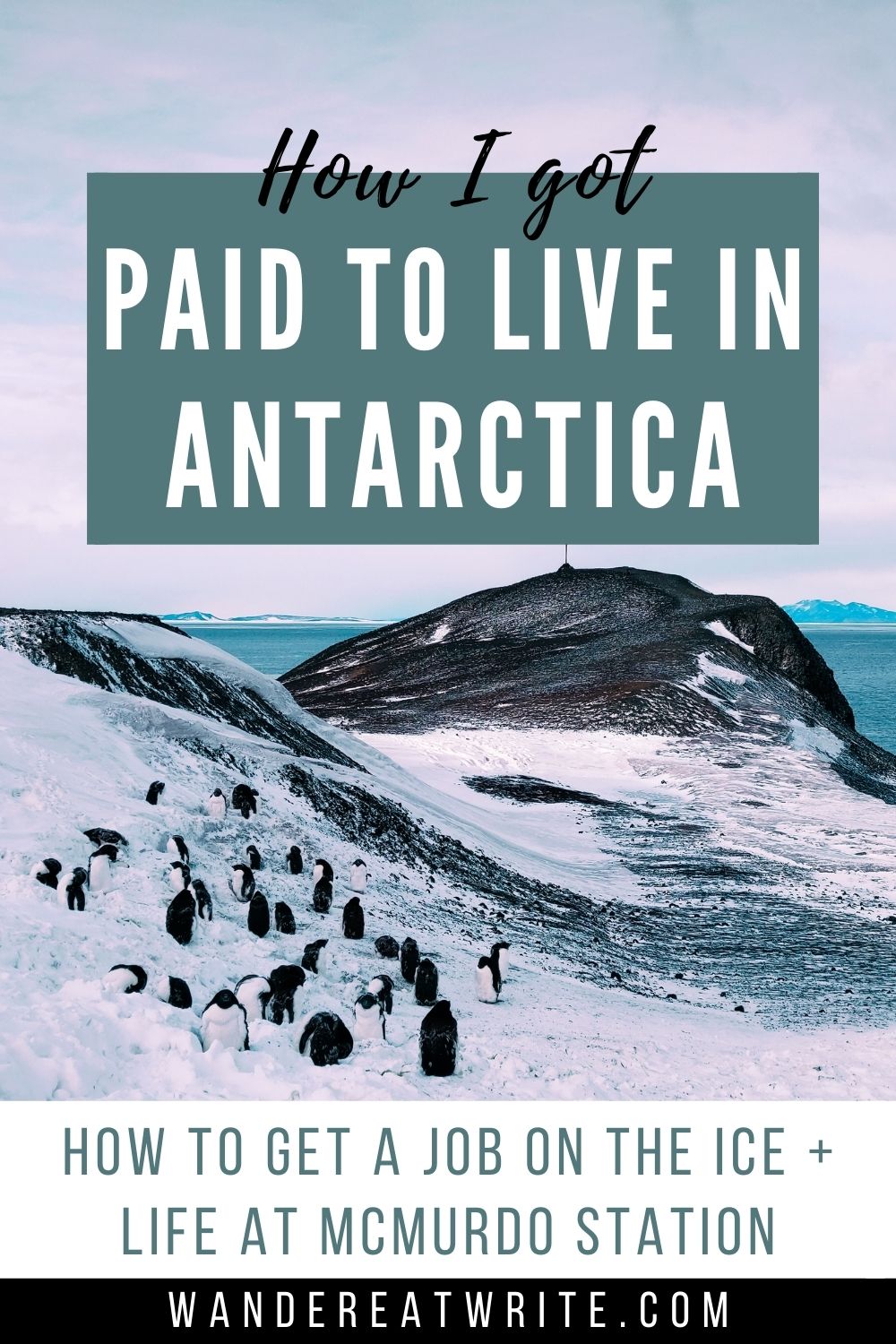


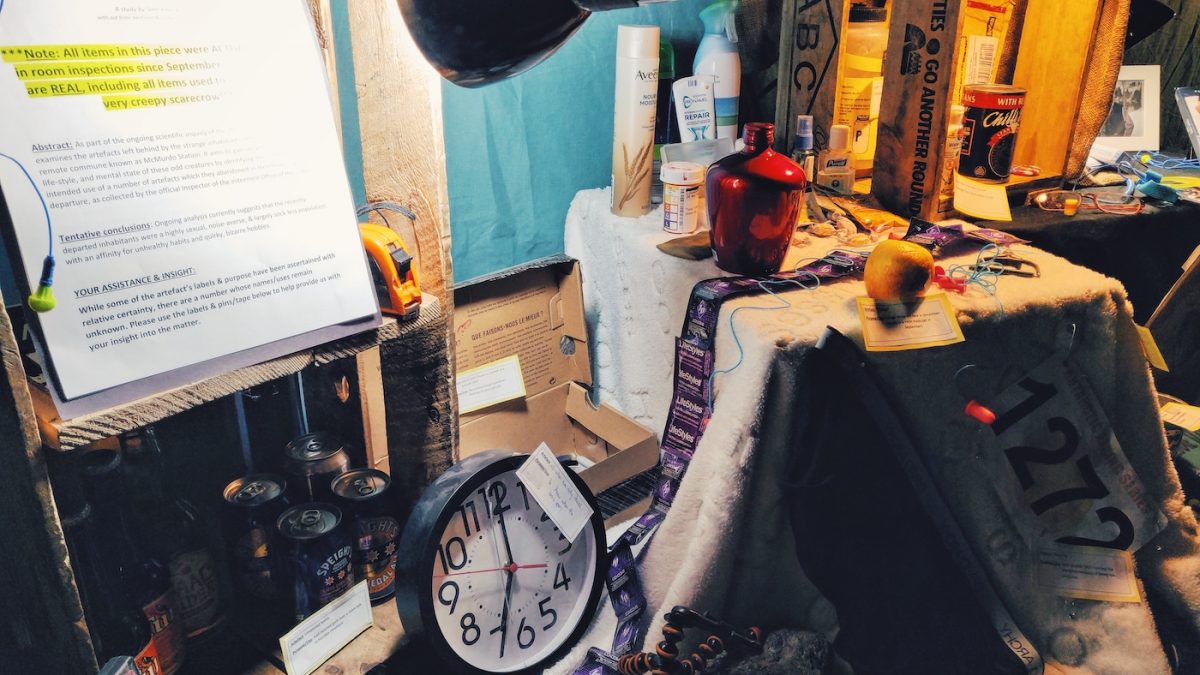






This is so interesting! I found your blog from Pinterest and can’t wait to read about your other jobs. I’d love to visit Antarctica one day but I don’t think I could ever work there. However I loved reading your experience and getting an inside glimpse at what it was like!
Glad you enjoyed it! It’s definitely not for everyone but I’m happy I could show you a little bit of what life is like down there :)
This is SO interesting. What a unique place and an unforgettable experience you’ve had. I don’t think I could work 56 hours in 6 days, I’d need a month off to recover!
(Oh and why am I not surprised that there’s sexism even in the middle of nowhere…?!)
Sometimes you just gotta do what you gotta do for an epic adventure! And yeah, even at the end of the world, it can still be a tough place for women to feel comfortable. They don’t call it a harsh continent for nothing!
What a truly amazing experience! I didn’t even know that these opportunities existed. Thank you for breaking it down into countries as well, I was happily surprised to find that there are opportunities for Australians as well.
I think a lot of people are surprised to find out how many countries have facilities down there! Although they are considerably smaller than the main US one, there are definitely still opportunities.
Reading this has made me super jealous! This must have been an incredible experience and your photos are incredible.
The endless unique photo opportunities were definitely one of the main highlights!
How amazing it must be to experience this! I am truly impressed by the fact you did it to be honest! I am too afraid of the cold to tempt it myself but I loved reading your adventures in Antartica!
I’m a tropical fish myself and can’t stand weather below 60F/15C but I couldn’t pass up such an amazing opportunity! It also helped that my job was indoors :)
Wow what an exceptional experience! Thanks for your hard work and contribution to science!
It was definitely a once in a lifetime opportunity and an absolute privilege to make sure everyone working hard down there had clean dishes to eat off of!
Wow, this is so inspiring! I’ve often heard of people sailing to Antarctica, but this is my first time hearing about getting paid to work there. I don’t think I qualify, so I will live vicariously through you! 😍
Glad I got to share a rare slice of the world with you!
It is so cool that you lived and worked in Antartica! What an experience to have! Sounds like you have had a lot of other jobs abroad too. I’m going to check out your other posts for some ideas!
Your guide is so helpful and interesting too. I always knew scientists could work there, but I never thought that other people (support staff) could too. It makes sense though!
I never thought it was possible for non-scientists to go either until I learned more about it and the various opportunities, and then I was dead set on making it down!
Such an interesting post! My husband and I are trying to plan a trip to Antarctica for his 40th birthday next year, to happen in Jan/Feb 2022. The world has to be good to go by then, right??
I really hope so! Sounds like an epic birthday :)
Wow, this is one of the coolest posts i’ve ever read! i would love to go to antártica, but the UK only really has jobs for scientists.
Hopefully you can find another option for making it down!
This is such a fascinating article. I learned so much-thank you. I am sue you had an amazing experience.
Thanks for reading! It really was amazing.
I absolutely loved Antarctica and would love to do this! I’m definitely sending it to my husband as a bit of hint. Haha How long did you live down there? It would be so cool to see the 24 hour sun!
You definitely should! While it is a little more challenging to get contracts together, there are a number of couples down there. I was on the ice for 4 months :)
This is amazing!! I’ve been wondering how I’ll be able to go in Antarctica or whether they allow tourists there. I’m inspired! You have experienced what most people can’t and I just love how you put everything in detail.
Maybe you can make it down there too in the future ;)
Thanks for taking the time to share your experiences! I was searching for “life on McMurdo” while contemplating filling out an application to work there and came across your awesome page! Thanks again, and this made my mind to pursue the opportunity!
Glad I could help! It’s truly a once in a lifetime opportunity that I hope you get to experience :)
Antartica is one of those “once in a lifetime” opportunities you really can’t turn down if it interests you. I’d love to do it. Paid work with the chance to see one of the most unviolated landscapes and natural surroundings on this planet.
Interesting comments and notes in your article. I’ve seen a youtube video which talks about life there too, and they had the same information (about the fresh pizza, freshies, etc) so it gives a good overview. I never actually knew about the internet there, so I’m sure movie nights must be cherished aswell as the data that needs to be uploaded. Since phones on internet is banned for security poss phones too, i’m sure there’s a lot of people take cameras and SD cards to upload when they get back home
Great article, I’m a cook trying to get a job like you did. I’m also looking to travel the world like you have. Do you have any advise about how to get cooking jobs outside the US. Any info would be great, I got no plan ATM. Were I go when I go will completely on who hires me . Thank you and really can’t say it enough great informative arrival. From your avg. Six something, brown hair, bearded white guy.
Somehow I just stumbled across this blog. However I greedily read every single word of it. You have such a relaxed, easy to read and informal style of writing. I have always had a fascination with the remote harshness of both ‘Arctics’ and in fact deep space and your article was such a joy to read and so very very interesting and informative. Being an enthusiast photographer I would love to visit an area like this some day. Thank you so much.
Hi , Michelle, I loved reading your blog! I must say, you are spot-on with your observations about life on The Ice. I myself spent 2 years there as an Equipment Operator, during Summer 1983, and Winfly ’84-85. My time was spent at McMurdo, Willy Airfield, Siple Station, and South Pole station. I daresay, a lot has changed since then, but I gathered from your article that a lot has stayed the same. I have to say, I have great memories from down there, and it will probably remain as one of the most epic times of my life. I ‘d love to hear more about your time at Pole, with the new station and all. I was there during the time when South Pole station was under the Dome.
Hi Bruce, thanks for reading! Physically, I’m sure a ton has changed in all of the stations, camps, and fields you worked in. I’m a little jealous you got to experience Pole with the Dome– I’ve definitely wondered about what life was like here with it! The elevated station feels a lot like a space ship. McMurdo seems like a different planet after being here for so long!
*Hey Michelle just read the whole part of your life in Antarctica and looking forward to go there one day and enjoy the place. You r damm good in explaining everything so vastly and paitiently. THANK YOU SOO MUCH!!!!! Regards, Paul
is there any specific kind of experience we need to go to Antarctica or any one can go?